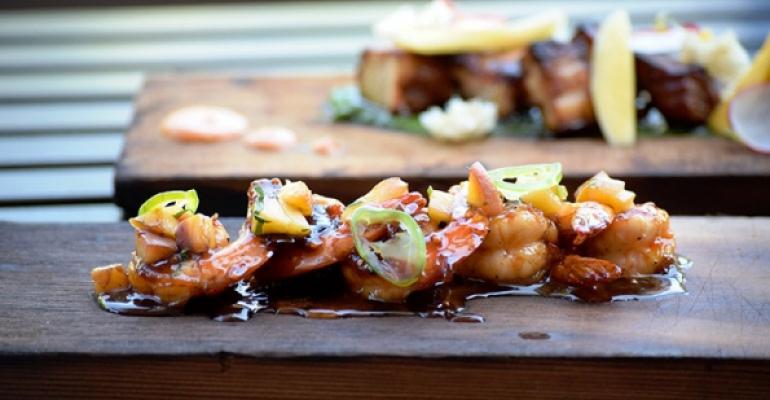The chile’s roots may be in ancient South America, but it is now a global ingredient used by nearly every culture and cuisine.
Typically spicy, but sometimes with smoky, sweet or earthy qualities as well, varieties of the genus Capsicum have been spreading on restaurant menus in recent years as chefs look to use this versatile ingredient to add zing to dishes and to push diners’ increasingly adventurous palates.
According to the latest research from Datassential MenuTrends, 64 percent of all restaurant menus have a pepper on them. Spicy Asian peppers, such as Thai chile, shishito and ghost peppers, are among the fastest growing varieties.
 “Chiles are part of who I am, part of my culture, “said Lauro Romero, executive chef of Three Degrees in Portland, Ore. “Where I come from, you just eat chiles — like salt or black pepper. There’s incredible versatility in chiles, from sweet and fruity to hot and smoky — and then really hot. I like to use them to add more flavor or punch to dishes.”
“Chiles are part of who I am, part of my culture, “said Lauro Romero, executive chef of Three Degrees in Portland, Ore. “Where I come from, you just eat chiles — like salt or black pepper. There’s incredible versatility in chiles, from sweet and fruity to hot and smoky — and then really hot. I like to use them to add more flavor or punch to dishes.”
Romero draws on his Mexican heritage and the many cultures and kitchens he’s cooked in to create dishes that regularly incorporate chiles, either pickled, in sauces or in rubs.
For instance, pickled Fresno chiles add heat, sweetness and acidity, and complement crab and avocado in his crab toast. Additionally, he uses smoked Morita and ancho chiles to create his own version of shichimi togarashi, a peppery Japanese spice mix, which he uses as a rub on a barbecue shrimp appetizer topped with a stone fruit relish and sliced jalapeños.
A variety of chiles are at the forefront of chef Mike Randolph’s menu at Público, a Latin American-inspired concept in University City, Mo. Among his dishes that showcase chiles are pole beans with fermented chile butter and candied marcona almonds; and pork ribs with a chile rub, lime and garlic.
Randolph also highlights chiles in the restaurant’s fermented hot sauces, including a red one made with Fresno and Thai bird chiles, and a green one with jalapeño, poblano and serrano peppers that have been fermented with stevia leaves for sweetness.
“For us at Público, chiles can really make a dish pop,” Randolph said. “They are also a key component to our hot sauces, which guests love to experiment with to punch up dishes like our whole fish or tacos.”
Also using chiles across his menu is Bruce Kalman, chef of Union, a Northern Italian-meets-California cuisine restaurant in Pasadena, Calif. Chiles are an ingredient in Kalman’s pork meatball dish, which also has San Marzano tomatoes, caper berries and lardo. His roasted sprouting broccoli is spiked with garlic, Meyer lemon and chile, and his Gnocchi alla Romana is served in a sauce of heirloom tomatoes, Taleggio cheese and Calabrian chile.

“I love using chiles for different applications,” Kalman said. “When used properly, you can achieve different results. For example, we use red chile flakes at varying quantities in dishes to either add a spicy element to the dish, to enhance the heat of fresh chiles, or just a small pinch to balance the flavor profile of a dish.”
Chef Gerard Craft is featuring Calabrian chiles at two of his concepts: Taste, a cocktail and small plates spot, and Sardella, a newly opened seasonal restaurant with an Italian bent, both in St. Louis.
Currently, on the menu at Taste is roasted redfish with cauliflower purée, curried cauliflower pickles, golden raisin, Calabrian chile and parsley. At Sardella, Craft is using Calabrian chile in his charred green beans with roasted garlic custard and Calabrian chile vinaigrette with basil.
At Departure in Denver, the second location of Gregory Gourdet’s Pan-Asian restaurant, executive chef Khamla Vongsakoun is serving up crispy whole Colorado striped bass with galangal, Thai bird chile, fish sauce, lime juice, sugar and kaffir lime leaves. His prawns are served with hearts of palm, candied walnuts, scallions and a sauce of hoisin, dried chiles, sambal and sesame oil.
“Growing up my whole life eating Southeast Asian food and Mexican food, it’s hard to avoid the love for chiles and how it brings a dish together,” Gourdet said. “The average diner is becoming more and more adventurous with their various cultural dining experiences … which allows chefs to become more aggressive with bold flavors and spice.”





